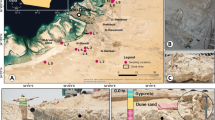Abstract
Engineering applications pose major challenge in designing structures that are safe, durable, and sustainable in various environmental situations. The slake durability index (SDI) test is commonly used to evaluate weak rock disintegration, such as evaporates, which are widely found in the Abu Dhabi area near the foundation levels, encountering construction challenges due to their disintegration. This study intends to provide insight into the disintegration characteristics of evaporitic rocks in the Abu Dhabi region under acidic and alkaline environmental conditions. Distilled water and groundwater which was collected from the study area is used as slaking fluids. As a result, rock blocks from the Abu Dhabi region, which is divided into four zones, were collected, and six sets of representative SDI test samples for each zone were prepared and tested using slaking fluids of pH values 2, 4, 6, 8, 10, and 12, as well as distilled water and groundwater. In addition, the macroscopic and microscopic (thin section, X-ray diffraction, X-ray fluorescence, and scanning electron microscopy) descriptions of representative samples from each zone were carried out. According to the findings, the overall average slakes durability weight loss of evaporates lies in the range of 60–72 wt% and could be classified as medium durably for Zones 1 and 4 under the basic environment, and for Zones 2 and 3 under the acidic environment. Thus, this study delivers the detailed explanation about the slaking characteristics of evaporitic rocks under various pH level conditions for engineers and decision makers to overcome degradability problems.




Similar content being viewed by others
Data Availability
The datasets generated during and/or analyzed during the current study are available from the corresponding author on reasonable request.
References
Dhakal, G.; Yoneda, T.; Kato, M.; Kaneko, K.: Slake durability and mineralogical properties of some pryroclastic and sedimentary rocks. Eng. Geol. 65, 31–45 (2002). https://doi.org/10.1016/S0013-7952(01)00101-6
Afolagboye, L.O.; Owoyemi, O.O.; Akinola, O.O.: Effect of pH condition and different solution on the slake durability of granitic rocks. Geotech. Geol. Eng. 41, 897–906 (2023). https://doi.org/10.1007/s10706-022-02312-5
Arman, H.: Effects of slaking fluid pH on the index properties of carbonate rocks. Geotech Geol Eng 39, 5843–5855 (2021). https://doi.org/10.1007/s10706-021-01870-4
Arman, H.; Hussein, S.; Abouhaligah, H.E.; Osman, M.; Baloch, M.A.; Hag, D.B.A.; Algaishi, H.A.A.: Predicting weathering characteristics of carbonate rocks under different geo-environmental conditions. IOP Confer. Ser. Earth Environ. Sci. 362, 012016 (2019). https://doi.org/10.1088/1755-1315/362/1/012016
Arman, H.; Abdelghany, O.; Abu Saima, M.; Aldahan, A.; Paramban, S.: Slaking behavior of evaporitic rocks from Abu Dhabi area, United Arab Emirates. Arab. J. Geosci. 14, 924 (2021). https://doi.org/10.1007/s12517-021-07295-w
Ghobadi, M.H.; Momeni, A.A.: Assessment of granitic rocks degradability susceptive to acid solutions in urban area. Environ. Earth Sci. 64, 753–760 (2011). https://doi.org/10.1007/s12665-010-0895-6
Ghobadi, M.H.; Mousavi, S.: The effect of pH and salty solutions on durability of sandstones of Aghajari Formation in Khouzestan province, southwest of Iran. Arab. J. Geosci. 7, 641–653 (2014). https://doi.org/10.1007/s12517-012-0741-0
Ghobadi, M.H.; Kapelehe, M.: The influence of pH of water and chemical composition on the durability of different rocks from Qom Formation, East and Northeast of Hamedan, Iran. J. Eng. Geol. 10, 3699–3718 (2017). https://doi.org/10.18869/acadpub.jeg.10.4.3699
Gupta, V.; Ahmed, I.: The effect of pH of water and mineralogical properties on the slake durability (degradability) of different rock from the Lesser Himalaya, India. Eng. Geol. 95, 79–87 (2007). https://doi.org/10.1016/j.enggeo.2007.09.004
Kayabali, K.; Beyaz, T.; Kolay, E.: The effect of the pH of the testing liquid on the slake durability of gypsum. Bull. Eng. Geol. Environ. 65, 65–71 (2006). https://doi.org/10.1007/s10064-005-0027-9
Mehdiabadi, N.; Abdi, Y.; Khanlari, G.: An experimental investigation on the durability of clay-bearing rocks in different pH conditions. Geotech. Geol. Eng. (2023). https://doi.org/10.1007/s10706-023-02418-4
Singh, T.N.; Singh, S.K.; Misra, A.; Singh, P.K.; Singh, V.K.: Effect of acidic water on physico-mechanical behavior of rock. Indian J. Eng. Mater. Sci. 6, 66–72 (1999). http://nopr.niscair.res.in/handle/123456789/21983
Yagiz, S.: The effect of pH of the testing liquid on the degradability of carbonate rocks. Geotech. Geol. Eng. 36, 2351–2363 (2018). https://doi.org/10.1007/s10706-018-0467-1
ASTM, D4644-16: Standard test method for slake durability of shales and other similar weak rocks. ASTM International, West Conshohocken (2016)
Geological Map of Al Ain. Digital Map: 1:100 000. United Arab Emirates, United Arab Emirates Ministry of Energy, Department of Geology and Mineral Resources (2006)
Franklin, J.A.; Chandra, R.: The slake-durability test. Int. J. Rock. Mech. Min. 9, 325–328 (1972). https://doi.org/10.1016/0148-9062(72)90001-0
Acknowledgements
The authors are grateful to express their sincere thanks to Dr. Osman Abdelghany, Dr. Mahmoud Abu Saima, and Dr. Bahaa Mahmoud for their contributions in the macroscopic and microscopic description of rock samples.
Funding
This work was supported by a grant from the United Arab Emirates University, Research Affairs, National Water and Energy Center (NWEC) under the title of NWEC-4-2018-31R193.
Author information
Authors and Affiliations
Corresponding author
Ethics declarations
Conflict of Interest
The authors declare that they have no known competing financial interests or personal relationships that could have appeared to influence the work reported in this paper.
Rights and permissions
Springer Nature or its licensor (e.g. a society or other partner) holds exclusive rights to this article under a publishing agreement with the author(s) or other rightsholder(s); author self-archiving of the accepted manuscript version of this article is solely governed by the terms of such publishing agreement and applicable law.
About this article
Cite this article
Arman, H., Paramban, S. Evaporitic Rocks Disintegration under Various pH Levels as Slaking Fluid. Arab J Sci Eng 49, 815–825 (2024). https://doi.org/10.1007/s13369-023-08002-5
Received:
Accepted:
Published:
Issue Date:
DOI: https://doi.org/10.1007/s13369-023-08002-5




